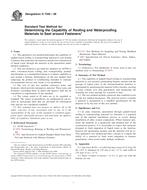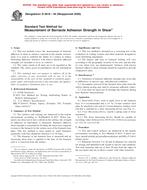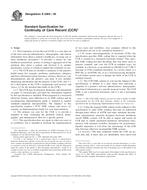1.1 This test method covers complete microwave susceptors.
1.2 This test method covers a procedure for quantitating volatile compounds whose identity has been established and which are evolved when a microwave susceptor sample is tested under simulated use conditions.
1.3 This test method was collaboratively evaluated with a variety of volatile compounds (see statistical evaluation). For compounds other than those evaluated, the analyst should determine the sensitivity and reproducibility of the method by carrying out appropriate spike and recovery studies. The analyst is referred to Practice E 260 for guidance.
1.4 For purposes of verifying the identity of or identifying unknown volatile compounds, the analyst is encouraged to incorporate techniques such as gas chromatography/mass spectroscopy, gas chromatography/infrared spectroscopy, or other techniques in conjunction with this test method.
1.5 A sensitivity level of approximately 0.025 μg/in. is achievable for the compounds studied in Table 1. Where other compounds are being quantitated and uncertainty exists over method sensitivity, the analyst is referred to Practice E 260 for procedures on determining sensitivity of chromatographic methods.
1.6 The values stated in SI units are to be regarded as standard. No other units of measurement are included in this standard.
1.7 This standard does not purport to address all of the safety concerns, if any, associated with its use. It is the responsibility of the user of this standard to establish appropriate safety and health practices and determine the applicability of regulatory limitations prior to use. Specific safety hazards warnings are given in 10.2, 11.1, and 11.6.
TABLE 1 Analyte Recovery Without Microwaving
| Compound | (n)A | Recovery Mean, % | Within Laboratory Variability, % | Overall Variability, % | Note(s)B |
|---|---|---|---|---|---|
| Benzene | 5 | 97.7 | 7.8 | 9.0 | |
| 2-Butoxy-ethanol | 4 | 98.7 | 6.7 | 8.4 | 1 |
| Dibutyl Ether | 5 | 109.7 | 16.5 | 23.7 | |
| Dodecane | 3 | 101.1 | 10.7 | 10.7 | 1, 2 |
| 2-Furfural | 4 | 99.7 | 11.7 | 12.0 | 1 |
| Furan- 2-Methanol |
3 | 100.0 | 14.1 | 16.4 | 1, 3 |
| Isobutyl Alcohol | 4 | 96.0 | 7.1 | 7.9 | 4 |
| Methylene Chloride |
5 | 103.5 | 16.7 | 22.6 | |
| 2-Propanol | 3 | 99.9 | 11.4 | 12.0 | 4 |
| Styrene | 5 | 100.8 | 8.5 | 9.3 | |
| Toluene | 4 | 102.7 | 9.9 | 10.9 | 4 |
| Overall | 101.1 | 11.6 | 14.4 |
A n = number of laboratories submitting data on compound.
B Notes: Collaborating laboratories provided the following reasons for not sub-
mitting data on a particular analyte:
1. The analyst felt interaction was occurring among various analytes and spent several days investigating. The laboratory manager refused to allow additional time for collaborative study.
2. The analyst questioned the solubility of the analyte and did not add to the spike mixture.
3. A fresh standard was not prepared fresh daily. This compound degrades measurably in water in 24 h.
4. The analyst experienced coelution of peaks under conditions of collaborative study on his/her particular system.
Product Details
- Published:
- 10/01/2008
- Number of Pages:
- 5
- File Size:
- 1 file , 87 KB


